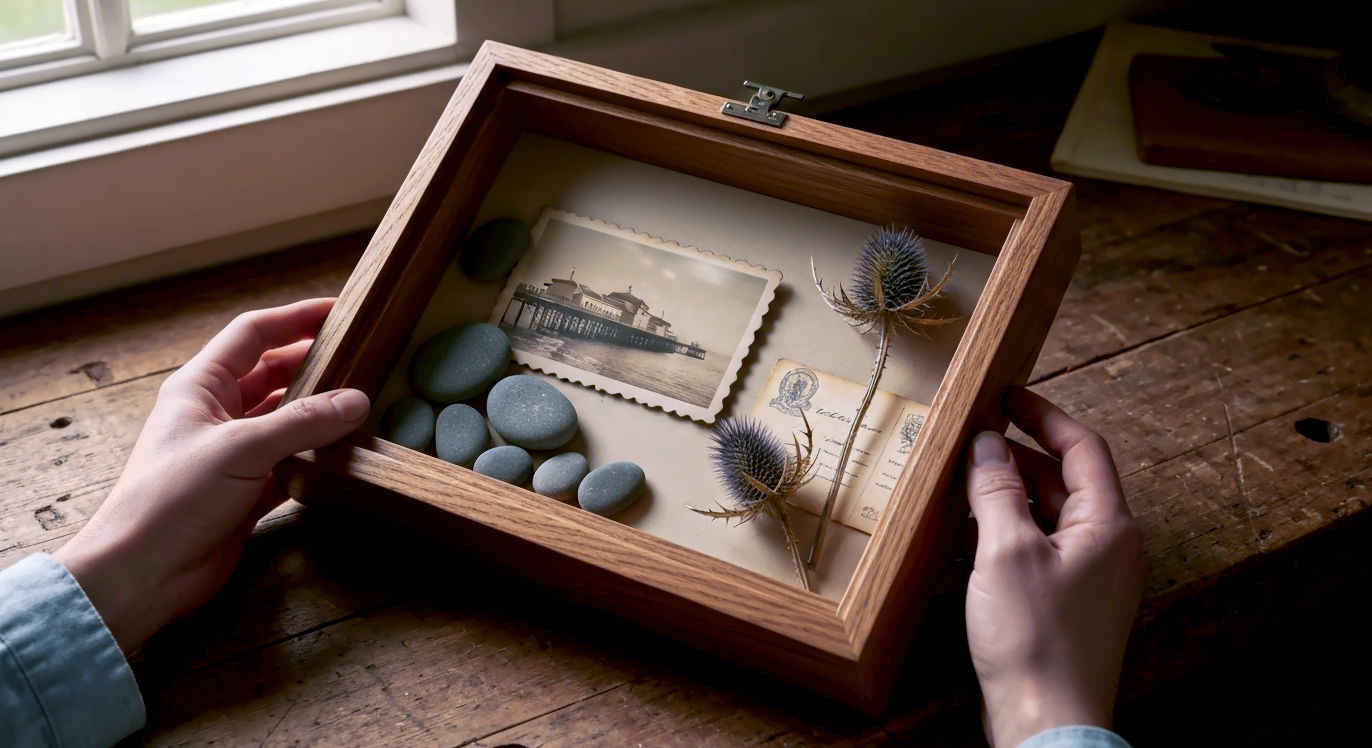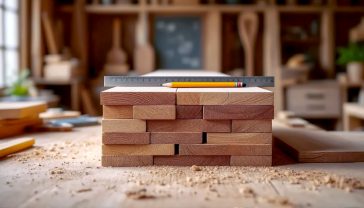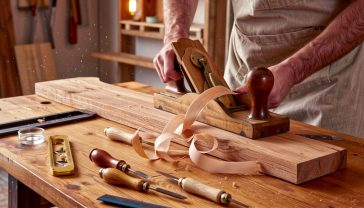More Than Just a Box: The Ultimate Guide to Crafting and Cherishing Shadow Boxes
Your definitive guide to shadow boxes. Explore their naval origins, learn to display military medals, and get creative ideas for weddings, babies, and travel.

This post may contain affiliate links. If you make a purchase through these links, we may earn a commission at no additional cost to you.
Ever stumbled upon a dusty old box in the attic, filled with faded photographs, a grandparent’s military medals, or tiny trinkets from a childhood holiday? We’ve all got them. Little collections of memories, tucked away and almost forgotten. But what if you could turn that jumble of treasures into a beautiful piece of art that tells a story? That’s where the magic of a shadow box comes in.
Think of a shadow box not just as a frame, but as a miniature stage for your memories. It’s a deep, enclosed display case that lets you arrange and protect objects that mean the world to you. From a soldier’s service medals to a baby’s first shoes, a shadow box transforms everyday items into a stunning visual narrative. It’s a craft that’s part scrapbooking, part interior design, and wholly personal.
For generations, we Brits have been masters of preserving history, whether it’s a grand castle or a humble family heirloom. Shadow boxes tap right into that tradition. They’re a wonderfully creative way to honour the past, celebrate the present, and create something truly unique for your home. Forget flat, boring picture frames; this is about giving your cherished memories the depth and prominence they deserve.
In this guide, we’ll explore everything you need to know. We’ll delve into the fascinating history of shadow boxes, from their naval origins to their modern-day popularity. We’ll walk you through how to choose the right box, design a layout that tells your story, and preserve your items for years to come. Whether you’re a complete beginner or a seasoned crafter, you’ll find all the inspiration and practical advice you need to create a masterpiece. So, let’s get started and turn those forgotten treasures into a talking point.
What Exactly Is a Shadow Box? The Core Concepts Explained
At its simplest, a shadow box is a type of enclosed picture frame with added depth. Unlike a standard frame that holds a flat photograph, a shadow box is deep enough to hold three-dimensional objects. Imagine a shallow box with a glass front—that’s the basic idea.
This depth is the key to its charm. It allows you to create layers, arrange items in a visually interesting way, and protect them from dust, damage, and the fading effects of sunlight. The inside of the box is usually lined with a soft material like linen, velvet, or acid-free paper, which provides a neutral backdrop and helps to preserve the items within.
The Anatomy of a Shadow Box
Let’s break down the different parts of a typical shadow box to understand how it all works.
- The Frame: This is the outer structure, just like a normal picture frame. It can be made from wood, metal, or plastic and comes in all sorts of styles, from ornate and traditional to sleek and modern. The frame provides the structural support and sets the overall aesthetic.
- The Glazing: This is the clear front panel, which is usually made of glass or acrylic (perspex). Glass offers excellent clarity but can be heavy and fragile. Acrylic is lighter and shatter-resistant, making it a safer choice, especially for larger boxes or homes with children. Many options come with UV protection to prevent your precious items from fading.
- The Box or Casing: This is the deep part behind the frame that gives the shadow box its name. The depth can vary, from just a couple of centimetres to ten or more, depending on what you plan to display.
- The Backing Board: This is the rear panel of the box. It’s often made from foam board, cork, or wood. This is what you’ll mount your items onto. A good backing board is sturdy enough to hold pins, glue, or other fixings securely.
- The Liner: The inside of the box is often lined with fabric or decorative paper. This isn’t just for looks; a high-quality, acid-free liner helps protect your items from chemical damage over time. Common choices include linen, suede, or simple, archival-quality paper.
Shadow Box vs. Deep Frame vs. Display Case: What’s the Difference?
You might hear these terms used interchangeably, but there are subtle differences.
- A deep frame (or box frame) is very similar but is often designed with a specific purpose in mind, like framing a football shirt. The depth is usually fixed and might not be as generous as a true shadow box.
- A display case is a broader term for any container used to exhibit items. A shadow box is a type of wall-mounted display case. Other display cases might be freestanding cabinets or tabletop boxes, like those you’d see in a museum or a jewellery shop.
Essentially, a shadow box is the perfect middle ground. It’s more versatile than a standard frame and more personal and integrated into your home décor than a bulky display case. It’s a dedicated space on your wall to tell a single, focused story.
From Sea to Sitting Room: The Fascinating History of Shadow Boxes
The story of the shadow box is steeped in tradition and superstition, with its roots found not in art galleries, but on the high seas. The concept is believed to have originated with sailors in the 18th and 19th centuries.
A Sailor’s Legacy
Life at sea was tough and unpredictable. Sailors spent months or even years away from home, and their ship became their world. Over a long career, a sailor would accumulate a collection of personal items that told the story of their travels and achievements: knots they’d tied, tools they’d used, letters from home, and souvenirs from distant ports.
When a sailor retired, tradition dictated that they would build a ‘shadow box’ to house these mementos. But this wasn’t just a nice retirement project. There was a powerful superstition attached to it. It was believed that if the sailor’s shadow were to touch the dock before they themselves did, they would be cursed with bad luck or even death. To prevent this, their shipmates would ‘capture’ the sailor’s shadow by placing their belongings in a box, which was then presented to them as they departed the ship for the last time.
This tradition created a physical representation of their life at sea—a contained, protected ‘shadow’ of their career. These early naval shadow boxes were often crafted from the same wood as the ship itself, making them even more personal and symbolic.
The Military Tradition
The practice was soon adopted by other branches of the military. A soldier’s career is marked by medals, insignia, patches, and photographs. A military shadow box became the standard way to honour a service member’s career upon their retirement or discharge.
In the UK, you’ll see this tradition reflected in every regiment of the British Army, every station of the Royal Air Force, and every ship in the Royal Navy. These boxes are meticulously arranged according to strict protocol. The placement of medals, for example, follows a specific order of precedence, with the highest honours placed in the top left. The Union Jack is often folded into a neat triangle and given a place of honour.
These are not just displays; they are formal records of a life of service and sacrifice. They are presented in formal ceremonies and cherished by families for generations.
The Victorian Era and the Cabinet of Curiosities
While the military popularised the formal shadow box, the idea of displaying collections of objects has even deeper roots. During the Victorian era, the well-to-do had a fascination with collecting. Natural history specimens like butterflies, shells, and fossils, as well as archaeological finds and cultural artefacts, were displayed in cabinets of curiosities.
These were the precursors to modern museums. While not shadow boxes in the strict sense, they shared the same spirit: the desire to categorise, display, and tell a story through objects. The Victorians also loved crafts like scrapbooking and creating intricate floral arrangements under glass domes. This love for collecting and displaying personal treasures paved the way for the shadow box to move from a purely military tradition into the home.
The Modern Hobby
Today, shadow boxes are more popular than ever. The rise of crafting hobbies like scrapbooking, coupled with a renewed appreciation for handmade and personalised décor, has brought the shadow box into the mainstream.
Now, you’ll find shadow boxes used to celebrate every imaginable milestone:
- A new baby: Displaying their first pair of shoes, hospital bracelet, and a birth announcement.
- A wedding: Preserving the invitation, a dried flower from the bouquet, and the cake topper.
- A memorable holiday: Showcasing ticket stubs, a map of the area, seashells, and foreign coins.
- A sporting achievement: Framing a medal, a signed ticket, and a photo from the event.
The modern shadow box is a wonderfully democratic form of art. It’s accessible to everyone, regardless of skill level, and allows us to be the curators of our own lives. It’s a tradition that has sailed from the decks of warships into our living rooms, but its core purpose remains the same: to honour and preserve the stories that make us who we are.
How to Make a Shadow Box: A Step-by-Step Guide
Creating your own shadow box is a hugely rewarding project. It’s a chance to get creative and make something that’s not only beautiful but also deeply meaningful. Don’t worry if you don’t think of yourself as ‘crafty’—the process is straightforward. Here’s how to do it.
Step 1: Gather Your Treasures and Choose a Theme
Before you even think about buying a box, you need to decide what story you want to tell. This is the most important step, as it will guide all your other decisions.
Start by gathering all the items you’re considering. Lay them all out on a table. Look for a common thread. Is there a theme?
- A Person: A tribute to a parent, grandparent, or child. Items could include medals, glasses, a favourite pipe, a piece of jewellery, or letters.
- An Event: A wedding, graduation, or a significant birthday. Think invitations, photos, favours, or dried flowers.
- A Hobby: A collection celebrating a passion like gardening (seed packets, old tools, pressed flowers), music (ticket stubs, a plectrum, setlist), or baking (an old family recipe, antique cookie cutters).
- A Holiday: A trip to the Cornish coast could be remembered with seashells, a local map, a postcard, and a photo of a windswept walk.
- A Period of Time: Your university days, your child’s primary school years, or even a tribute to a decade like the 1980s (cassette tapes, badges, photos).
Once you have your theme, select the most important items. Be ruthless! You can’t include everything. Choose the objects that best tell the story and have the most emotional resonance. Make sure you have a variety of shapes, sizes, and textures to create visual interest.
Step 2: Select the Perfect Shadow Box
Now that you know what you want to display, you can choose your box. Consider these factors:
- Size and Depth: Arrange your selected items on a piece of paper, leaving a little space between them. Measure the area they cover. This will give you a rough idea of the height and width you need. Then, find your thickest object. The box must be at least that deep, ideally with a centimetre or two to spare so it doesn’t look squashed against the glass.
- Style and Colour: The frame should complement both the items inside and the room where you plan to hang it. A rustic wooden frame might be perfect for a collection of gardening tools, while a sleek black frame would suit modern concert memorabilia. The colour of the interior lining is also crucial. A neutral colour like cream, grey, or black usually works best, as it makes your items pop.
- Material: Wooden frames are classic and durable. Metal frames offer a more modern look. Plastic frames are a budget-friendly option. For the glazing, UV-protective glass or acrylic is a wise investment to prevent your treasures from fading.
You can buy shadow boxes from craft shops like Hobbycraft, home décor stores, or online. For something truly special, consider visiting a local framing shop. They can create a custom box to your exact specifications.
Step 3: Design Your Layout
This is where your inner artist gets to shine. The goal is to create a balanced and visually pleasing arrangement that tells your story clearly.
- Find a Focal Point: Every good design has a focal point. This is the most important item in your collection—perhaps a large photograph, a medal, or a central souvenir. Place this first, usually slightly off-centre to make the layout more dynamic.
- Work from Largest to Smallest: Arrange the larger, heavier-looking items first, typically towards the bottom of the box. This creates a sense of visual balance. Then, fill in the spaces with the smaller, lighter items.
- Create Depth and Layers: Don’t just lay everything flat. Overlap items slightly. Place some things further back and some closer to the front. You can use small pieces of foam board or balsa wood to raise certain items off the back, creating literal shadows and a more three-dimensional effect.
- Think About Flow: Your eyes should be able to move smoothly across the display. Try to arrange items in a way that leads the viewer from one piece to the next. This could be a gentle S-curve, a diagonal line, or a circular pattern.
- Take a Picture: Before you fix anything permanently, arrange everything on the backing board outside of the box. Play around with different layouts. When you find one you like, take a photo of it with your phone. This will be your guide when it’s time to secure everything in place. It’s amazing how quickly you can forget the perfect arrangement once you start fiddling with pins and glue!
Step 4: Prepare the Backing Board and Items
Before you start mounting, make sure your backing board is ready. If you want to cover it with fabric or decorative paper, now is the time. Cut the material slightly larger than the board, wrap it tightly around, and secure it at the back with tape or a staple gun. Ensure it’s smooth and free of wrinkles.
Clean your items carefully. Gently wipe away any dust or fingerprints. For fabrics, make sure they are clean and pressed.
Step 5: Mount Your Items
This is the final, and most delicate, step. How you attach your items will depend on what they are. The golden rule is to use methods that are reversible and non-damaging where possible, especially for valuable or fragile items.
- Pins: Stainless steel sewing pins or special archival pins are great for attaching fabric, paper, and other light items. You can push them through the item into the foam or cork backing board. For a neater look, you can often hide the pinheads behind another overlapping item.
- Glue: For heavier items, you may need glue. Use a specialist craft glue or a hot glue gun. Always use acid-free glue for paper and photos to prevent them from yellowing. Apply the glue sparingly to the back of the item and press it firmly onto the board. Be careful not to use too much, or it will seep out the sides.
- Archival Mounting Strips or Corners: These are perfect for photographs and documents. They are self-adhesive strips that hold the item in place without any glue touching the photo itself.
- Stitching: For delicate textiles or clothing (like a baby’s bonnet), you can use a needle and thread. A few small, discreet stitches in a matching colour can hold the item securely to the fabric-covered backing board.
- Small Hooks or Wire: For heavier objects like medals or pocket watches, you might need to use small hooks screwed into the backing board or create a wire mount.
Work slowly and carefully, using your reference photo. Start with the background items and work your way forward.
Step 6: Final Assembly
Once everything is securely mounted, it’s time for the big reveal.
- Clean the Glass: Clean both sides of the glass or acrylic panel thoroughly. Any fingerprints or smudges will be very obvious once the box is sealed.
- Assemble the Box: Carefully place the backing board with your mounted items back into the frame.
- Secure the Back: Fasten the back panel in place using the clips or tabs provided.
- Add Hanging Hardware: Attach the wire or hooks to the back of the frame.
- Hang and Admire: Find the perfect spot on your wall, hang your masterpiece, and stand back to admire your work. You’ve just created a beautiful, personal piece of art that will be cherished for years.
Creative Shadow Box Ideas for Every Occasion
Now that you know the ‘how’, let’s get to the fun part: the ‘what’. A shadow box can be a canvas for almost any story. Here are some ideas to get your creative juices flowing, tailored for different life events and hobbies.
For Family Milestones
These are the big moments that deserve to be celebrated and remembered.
- New Baby Shadow Box: This is a classic for a reason. Combine the baby’s hospital identity bracelet, their first hat or booties, a photo from their first day, and their birth announcement. You could also include a clay impression of their tiny hand or foot. Use a soft, pastel-coloured background.
- Wedding Day Memory Box: Preserve the magic of the big day. Include your wedding invitation, a dried flower from the bouquet or buttonhole, the cork from the champagne bottle, a piece of lace from the dress, and a photo of the happy couple. A sophisticated linen background works beautifully here.
- Graduation Tribute: Celebrate academic achievement. Frame the graduation certificate alongside the tassel from the mortarboard, a photo from the ceremony, and a pin or crest from the university. You could even include a small, symbolic book related to their field of study.
For Hobbies and Passions
Showcase what you love. A shadow box is a fantastic way to display your hobbies with pride.
- The Gardener’s Box: For those with green fingers. Arrange beautiful pressed flowers from your garden, vintage seed packets, a small hand trowel, and a pair of worn gardening gloves. A rustic, weathered wood frame would be perfect.
- The Music Lover’s Display: Commemorate a favourite band or a memorable concert. Frame ticket stubs, a festival wristband, a guitar plectrum, a printed setlist, and a photo of the artist. A sleek, black frame gives it a cool, rock-and-roll vibe.
- The Avid Reader’s Collection: A tribute to a beloved author or book. You could frame a first edition (if you’re lucky!), a signed bookplate, a favourite quote printed in a beautiful font, and items that relate to the story—for example, a vintage key and a magnifying glass for a Sherlock Holmes box.
- The Sports Fan’s Shrine: Celebrate your team’s victory or your own sporting achievements. Mount a medal, a signed ticket, a team scarf or rosette, and a photo from the big match. Use the team’s colours for the background.
For Travel and Adventures
Don’t let your holiday memories fade away in a photo album. Bring them to life.
- A Trip to the Seaside: Perfect for remembering a British coastal holiday. Fill the box with seashells, smooth pebbles, a piece of driftwood, a local map, and a postcard from St Ives or Whitby. You could even add a little sand at the bottom (make sure it’s well-sealed!).
- City Break Memories: Capture the essence of a trip to London, Edinburgh, or further afield. Use ticket stubs from the theatre or a museum, a transport pass (like an Oyster card), a few foreign coins and notes, and a stylish black-and-white photo of a famous landmark.
- The Hiker’s Journal: For those who love the great outdoors. Display a map of a favourite walking route in the Peak District or the Scottish Highlands, a compass, a patch from your walking group, and photos of stunning views. A natural oak frame would complement the theme perfectly.
Tributes and Memorials
A shadow box can be a beautiful and sensitive way to remember a loved one.
- In Loving Memory Box: Create a tribute to a family member who has passed away. This is a very personal project, so choose items that truly capture their spirit. It could be their glasses, a favourite pen, a piece of their jewellery, a treasured recipe in their handwriting, or a medal from their service. The goal is to create a display that brings back warm and happy memories.
- A Tribute to a Beloved Pet: Our pets are part of the family. Remember a loyal companion with a shadow box containing their collar and tag, a favourite toy, their paw print in clay, and a lovely photo of them.
Top Tip: Don’t be afraid to include text. A small, neatly printed label for each item, a meaningful quote, or a short description of the event can add context and depth to your story.
Common Pitfalls and How to Avoid Them
While making a shadow box is generally a straightforward process, there are a few common mistakes that can trip up beginners. Here’s what to watch out for to ensure your project is a success.
1. Overcrowding the Box
The Problem: It’s tempting to include every single memento you have. This often results in a cluttered, chaotic display where nothing stands out. The story gets lost in the noise.
The Solution: Edit, edit, edit! Before you start, choose a clear theme and stick to it. Select only the most significant items that contribute to the story. Remember the design principle: less is more. Leave some empty space (often called ‘negative space’) around your items. This gives them room to breathe and helps to draw the viewer’s eye to the focal points.
2. Poor Layout and Balance
The Problem: A randomly placed collection of objects can look unbalanced and messy. Placing all the heavy, dark items on one side, for example, can make the whole display feel lopsided.
The Solution: Plan your layout carefully. Use the tips we discussed earlier: establish a focal point, place heavier items at the bottom, and create a visual flow. Lay everything out on the backing board and live with it for a day or two before you fix anything down. Look at it from a distance and from different angles. Does it feel balanced? Does it tell a clear story? Don’t be afraid to move things around until it feels just right.
3. Using the Wrong Adhesives or Materials
The Problem: Using non-archival materials like standard sticky tape or acidic glue can damage your precious items over time. Paper and photos can turn yellow, and fabrics can become discoloured.
The Solution: Invest in acid-free, archival-quality materials. This is especially important for the backing board, any paper or fabric liners, and any adhesives you use. Look for products labelled ‘acid-free’, ‘archival’, or ‘photo-safe’ in craft shops. For valuable or irreplaceable items, use mounting methods that are reversible, like stainless steel pins, archival corners, or stitching.
4. Items Not Being Secure
The Problem: You hang your beautiful shadow box on the wall, and a week later, you notice an item has slipped or fallen to the bottom.
The Solution: Make sure every item is securely fastened. For light items like paper, a few well-placed pins will do. For heavier items, don’t be afraid to use a stronger adhesive like a hot glue gun or even small dabs of epoxy. If you’re using glue, make sure it’s completely dry before you assemble the box. For very heavy or awkward items, consider using a thin, clear wire to discreetly tie them to the backing board.
5. Forgetting About Preservation and Fading
The Problem: You hang your shadow box in a bright, sunny spot, and within a few months, you notice that your beautiful photos and colourful fabrics have started to fade.
The Solution: Light, especially direct sunlight, is the enemy of preservation. The ultraviolet (UV) rays in sunlight break down colours in paper, ink, and textiles.
- Choose the right location: Hang your shadow box on a wall that doesn’t get direct sunlight.
- Invest in UV-protective glazing: When buying your shadow box, look for one with glass or acrylic that has a UV-protective coating. It might cost a little more, but it’s a worthwhile investment to protect your memories for the long term.
By keeping these common pitfalls in mind, you’ll be well on your way to creating a professional-looking shadow box that is not only beautiful but also built to last.
The Future of Memories: Why Shadow Boxes Endure
In our increasingly digital world, you might wonder if something as tangible as a shadow box still has a place. We store thousands of photos on our phones, and our memories are documented in social media feeds. But that’s precisely why the shadow box is more relevant than ever.
A Tangible Connection to the Past
Digital photos are wonderful, but they exist behind a screen. You can’t touch them or feel their history. A shadow box offers a physical, multi-sensory connection to our memories. You can see the texture of your baby’s first blanket, the glint of a military medal, the faded ink on a handwritten letter. These objects have a weight and a presence that a digital file simply can’t replicate. They are real.
This physical connection is powerful. It grounds us and reminds us of where we’ve come from. In an age of fleeting digital content, the permanence of a shadow box feels reassuring and meaningful.
The Art of Curation
We are all curators of our own lives. We choose what to share and what to keep private. A shadow box is a deliberate act of curation. It forces us to think about what is truly important to us. Which objects best represent a person, an event, or a feeling?
This process of selecting and arranging items is a creative and mindful activity. It’s a way of making sense of our experiences and weaving them into a coherent story. It’s not just about preserving memories; it’s about understanding them.
A Sustainable and Personal Craft
The trend towards sustainable and handmade goods also supports the enduring appeal of the shadow box. It’s a form of upcycling, giving new life to old objects that might otherwise be hidden away in a drawer or, worse, thrown out.
Furthermore, in a world of mass-produced décor, a shadow box is a uniquely personal statement. It’s something that you have created, and it reflects your life and your taste. No one else in the world will have one exactly like it. It’s a conversation starter and a piece of your home that is infused with meaning.
The shadow box tradition has survived for centuries because it speaks to a fundamental human need: the need to remember, to honour, and to tell stories. From a sailor’s superstitious ritual to a modern-day craft project, its purpose has remained unchanged. It’s a way to hold on to the moments and people that matter most, and to give them a permanent, beautiful home. In the future, as our lives become ever more digital, the simple, tangible act of creating a shadow box will only become more precious.
Further Reading
For more inspiration and to purchase supplies, here are some highly respected resources:
- Hobbycraft: A fantastic UK retailer for shadow boxes, craft supplies, and archival materials. Their blog often features creative ideas and tutorials.
- The Royal British Legion: For information on the correct way to display military medals and the history behind this tradition.
- The Victoria and Albert Museum (V&A): Explore their collections online for inspiration on curation and display, drawing from the historical ‘cabinets of curiosities’.
- Professional Picture Framers Association (PPFA): Offers resources and a directory to find local, expert framers who can create custom shadow boxes and offer preservation advice.






